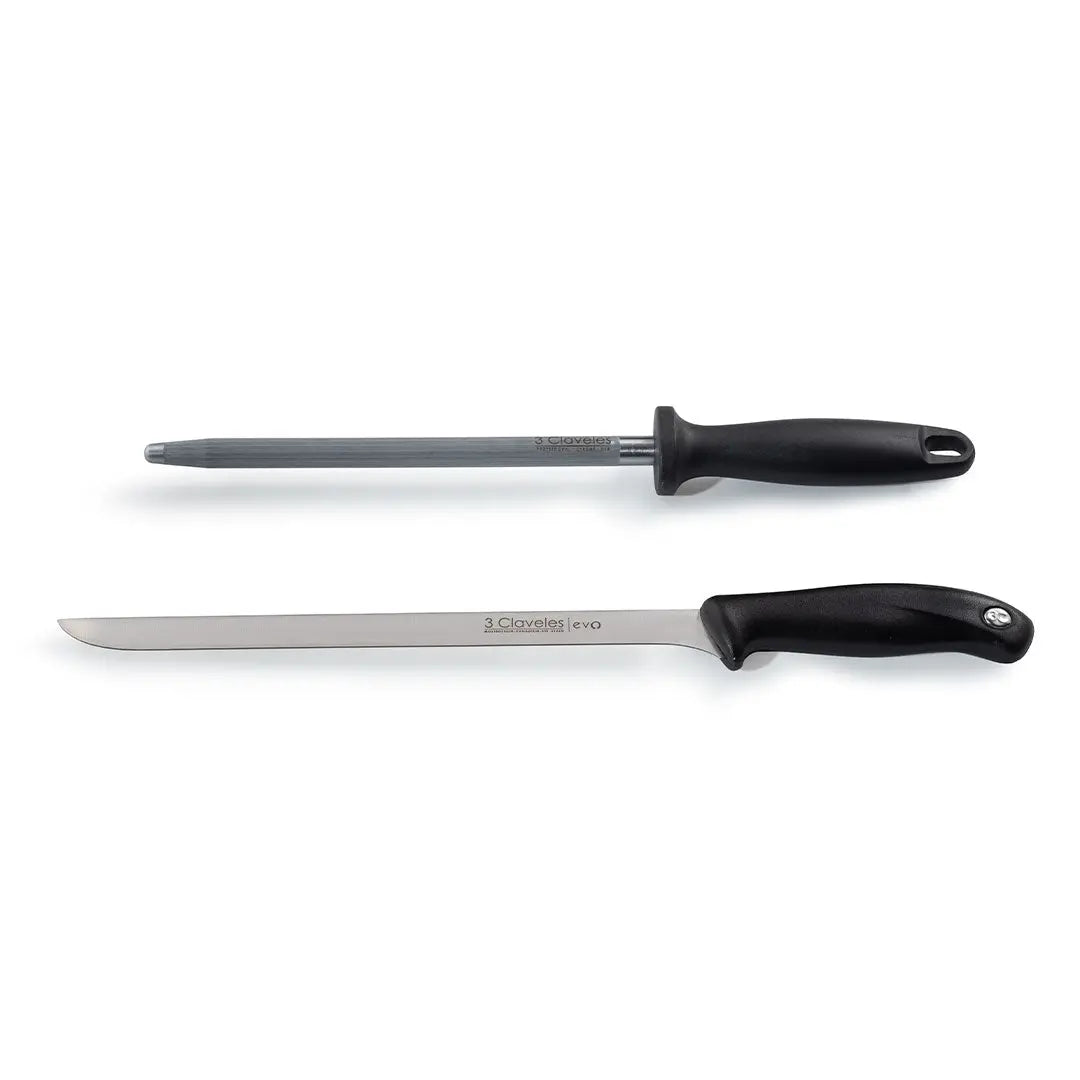
How to cut Spanish jamón/ham?
We know how magical it can be to have the whole piece of ham at home and be able to enjoy the experience of cutting each slice. The act of "cutting ham" becomes an authentic ritual for some of the enthusiasts of this product.
Keep in mind that, if you've never cut Spanish ham before or you feel unsure, it's best to start by learning with the best resources you have at hand, such as our ham-cutting tutorials here and also in video format.
Or if you prefer, you can buy it already sliced in packets because not only will you avoid hurting yourself, but you can also start by trying all the different cuts and later buy your own piece and start cutting with more confidence.
Therefore, if your goal is to enjoy the cutting experience and learn how it's done, in this post we will tell you step by step, presenting you with the most suitable tools and explaining how to use them properly at each moment.
Mastering the cutting technique is complicated and takes time; nevertheless – as in all aspects of life – attitude is everything. If you have the willingness to learn and follow these steps, you can do it easily and safely and effectively.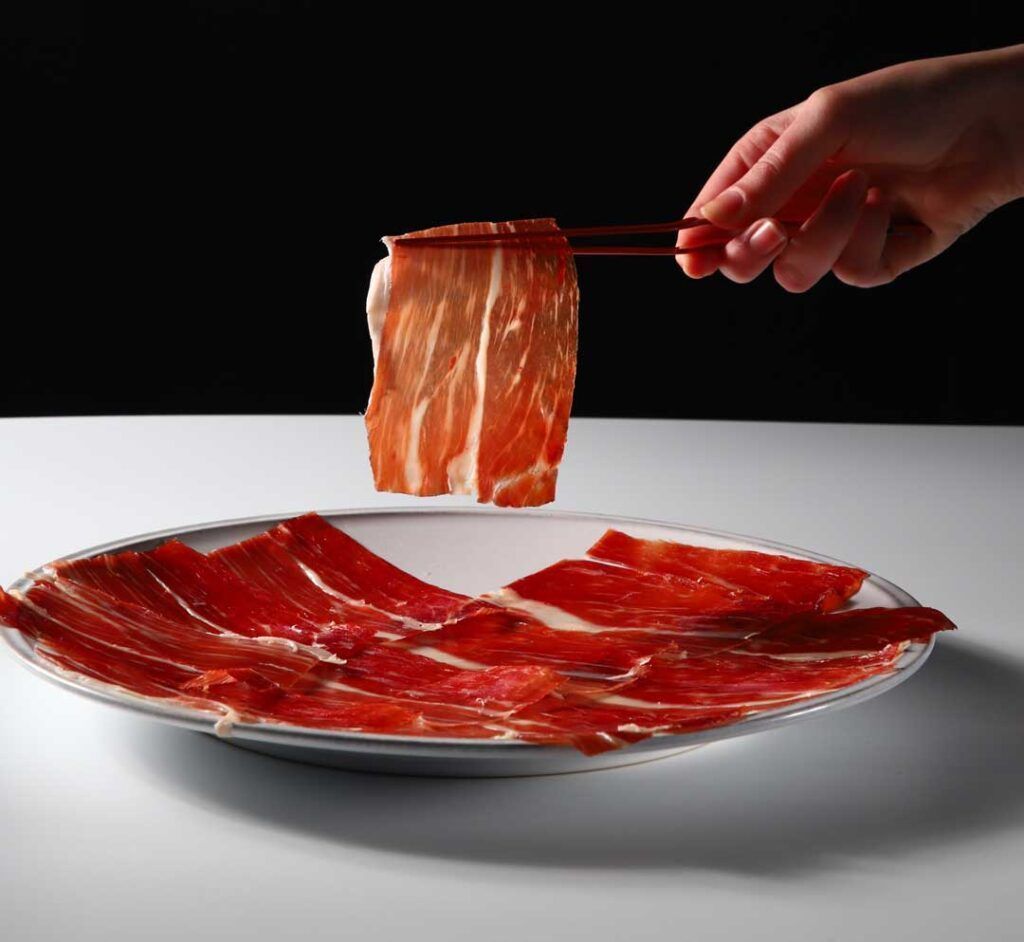
The Importance of Cutting Spanish Ham
The essence of enjoying a good ham is not only about it being a well-cured and high-quality product, but also about the cut. A proper ham cut is essential to fully appreciate its flavor and reveal its authenticity.
As our ham experts say: "A good product combined with a good cut results in a perfect slice that provides indescribable pleasure when eaten."
Therefore, it's logical that a bad cut can lead to the loss of nuances in taste and texture. Of course, it's impossible to cut a whole ham without making mistakes several times; even the best master slicers make mistakes sometimes. It's also not possible to cut the whole piece into slices using the same tool.
There are areas where the ham knife can't reach, and you need to cut them with a boning knife. The delicious shavings and small cubes of ham come from these areas, making excellent appetizers or ingredients that add life and flavor to any recipe.
Jamón knife and grindknives kit
Rotating ham holder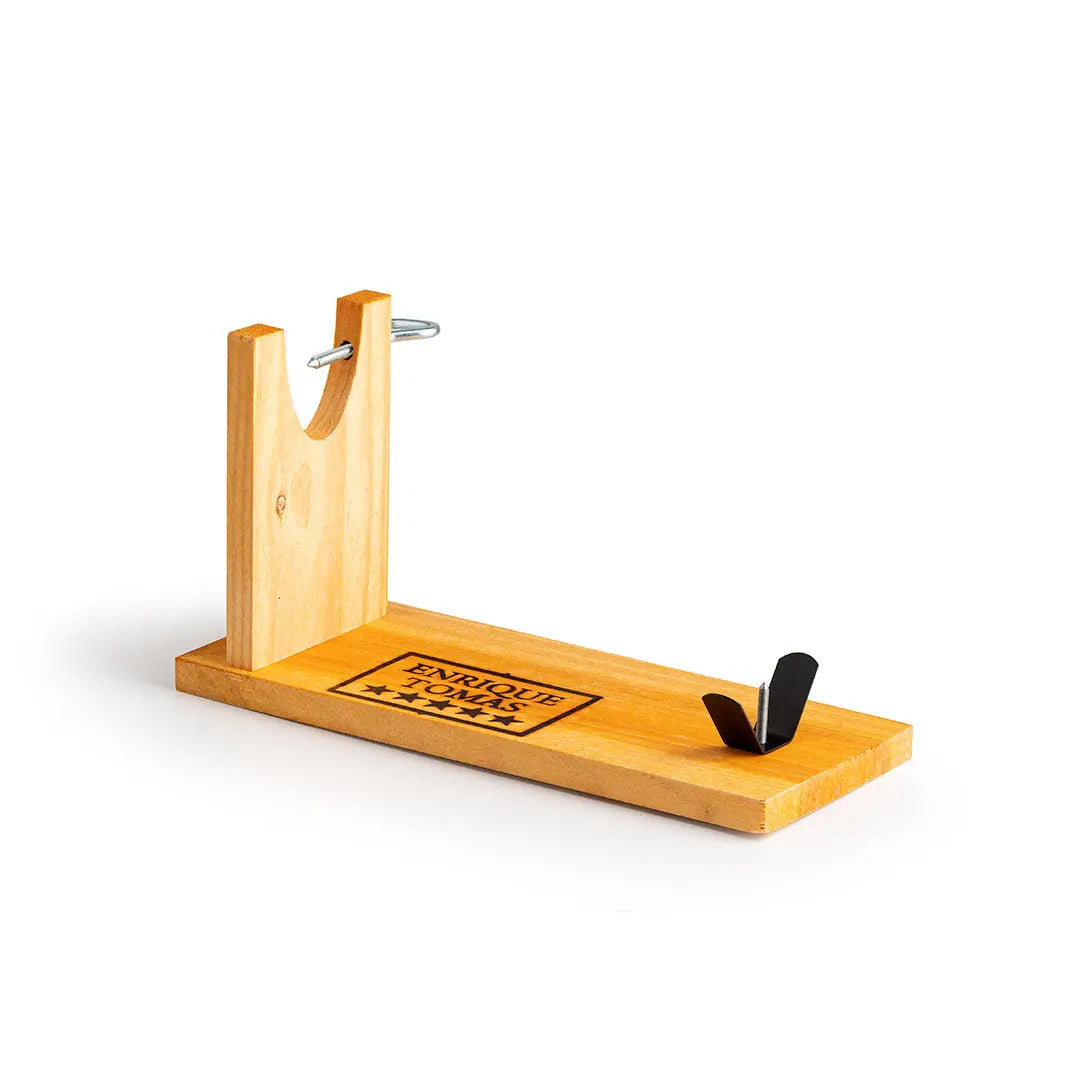
Professional ham holder - technical mode
Cutting utensils
What Utensils Are Necessary for Cutting Spanish Ham?
The utensils we use are of utmost importance to achieve a perfect, well-defined cut and to ensure safety for the cutter. We're talking about a ham holder, a ham knife, and a boning or paring knife. Of course, there are more tools, such as tongs to avoid touching the ham with your hands or protective gloves if you're a beginner. The latter are optional but not essential.
Utensils for Cutting Ham: The Ham Holder
There are various types and price ranges of ham holders. Their price usually ranges from >10 euros to <100 euros. The most important aspect is that they are secure and hold the ham or shoulder firmly in place, avoiding movement. Otherwise, poor stability can affect the cut and increase the risk for the cutter.
It's essential that the ham holder fits the size of the ham in question; not all ham holders are suitable for cutting any type of ham or shoulder. It depends on its weight and size. When purchasing one, consider the weight range that the ham holder covers.
Utensils for Cutting Ham: The Boning or Paring Knife
The boning knife is essential, firstly, for removing the rind and yellowish fat when opening the ham, and secondly, for getting the meat closest to the bone when it's no longer possible to slice the ham. This elongated blade knife should be rigid, with a wider blade towards the handle and narrower at the tip.

Utensils for Cutting Ham: The Ham Knife
The ham knife is the most famous utensil for cutting Spanish ham. It's about 30 cm long, with a sharp blade and a pointed tip. When using your ham knife, keep in mind that it's very sharp, and if not used correctly, it can cause cuts. Always remember that your hand should be positioned ALWAYS above the area you're slicing. This way, if it slips, you won't cut yourself.
Above all, the ham knife is the most important because it determines the cut of each slice. For this, it must be properly sharpened because if it doesn't cut well, you might hurt yourself by exerting too much force, and the slices will likely be too thick. So, invest in good cutting knives to start slicing.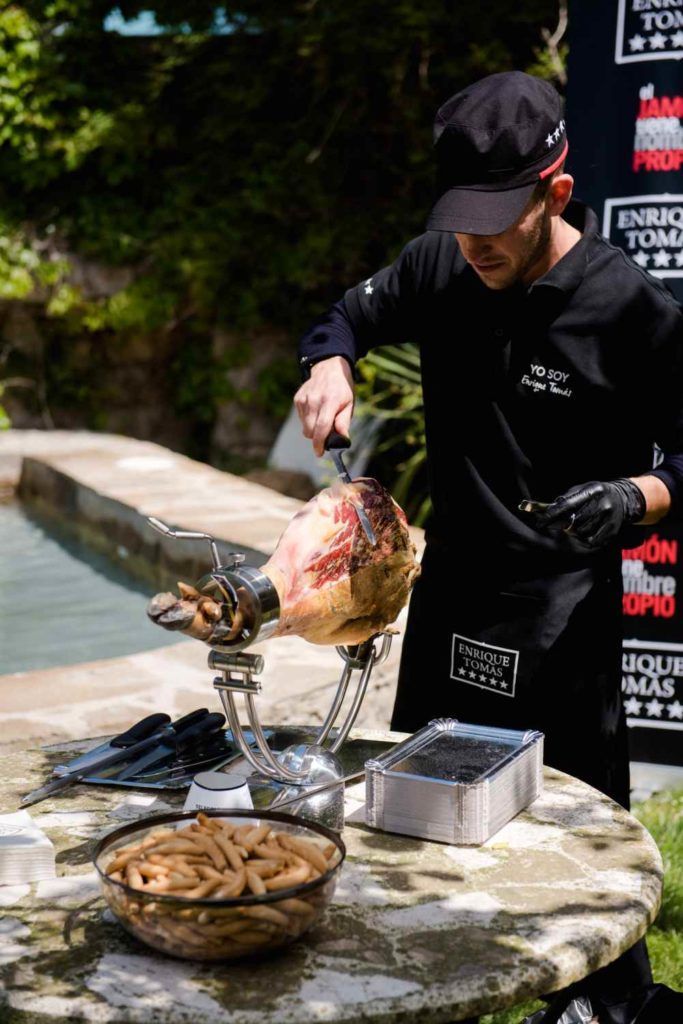
Cutting Spanish Ham: Step by Step
- Before starting to cut the ham, it's very important to secure the leg well in the ham holder to prevent movement and avoid accidents.
- Make a transverse and deep cut just below the "nuez" (the knob on the ham leg), using the boning knife, in a V-shape.
- Remove the rancid and yellowish fat layer to uncover the ham for slicing. Use a ham knife for this step. Caution: the hand that's not cutting should always be above the hand that's cutting or somewhere else, away from the knife.
- Use the boning knife to separate the meat from the bone, allowing you to continue slicing and making the most of the ham. As you cut, move down the leg until you reach the end.
- After each slice, cover the ham with a lint-free cloth to protect it from light and minimize exposure to air.
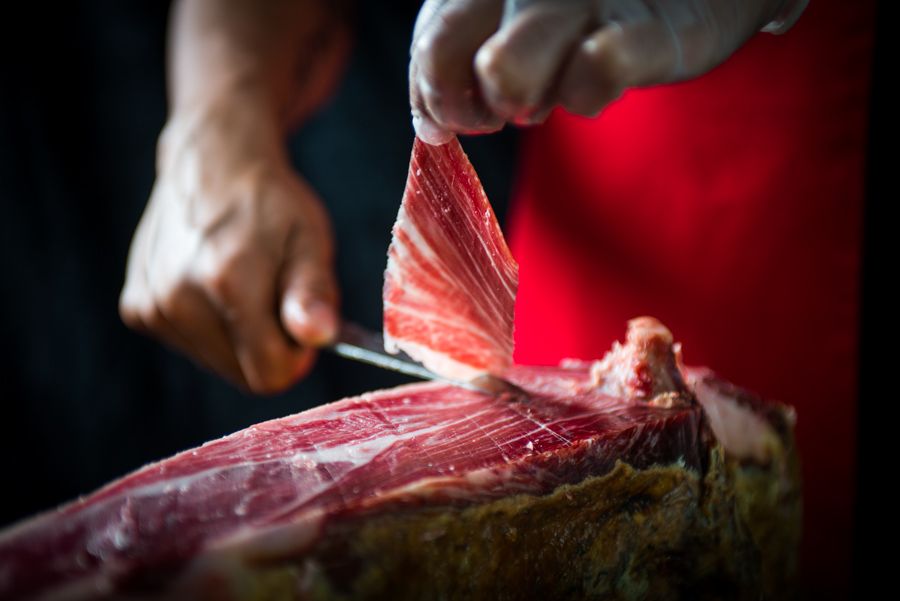 The Perfect Slice
The Perfect SliceHere's a summary video again, detailing step by step how to do it. If you have any questions, you can contact Enrique Tomás' customer service team, and we'll do our best to assist you.
Curiosities About Cutting Spanish Ham
There are several key points to consider when cutting Spanish ham, especially if it's your first time.
- It's essential to cut ham daily. If you see that you won't be able to do it, don't buy the whole leg; buy pre-sliced packets instead.
- A ham should be started from the narrower end, which is the more cured part.
- If you buy an Enrique Tomás ham, it's already at the ideal curing point for consumption. Don't delay starting it; otherwise, it can dry out excessively, and even spoil if environmental conditions aren't optimal. Once started, we recommend consuming it within three weeks to enjoy its authentic flavor 100%, maximum one month to prevent spoilage.
- Ham is a sensation, an emotion, which is why the cutting technique for each slice is crucial to enhance the flavor and evoke sensations. Remember that the slices shouldn't be too thick or too thin. This will allow the oil to cascade in your mouth, revealing the nuances of the piece. The pleasure will be unique!

In conclusion, the best slice is the one that easily melts in your palate without much effort in chewing, releasing a cascade of aromas and flavors.
Obviously, the degree of taste and textures will also depend on the type of ham and its curing time. However, undoubtedly, as you learn to cut, you'll realize that the cut plays a role in revealing the nuances in flavor and providing that perfect texture that makes it melt in your mouth.
